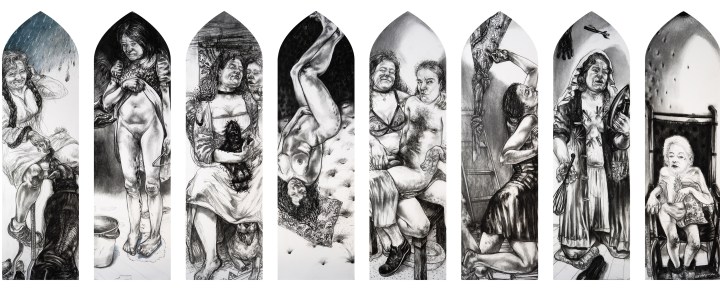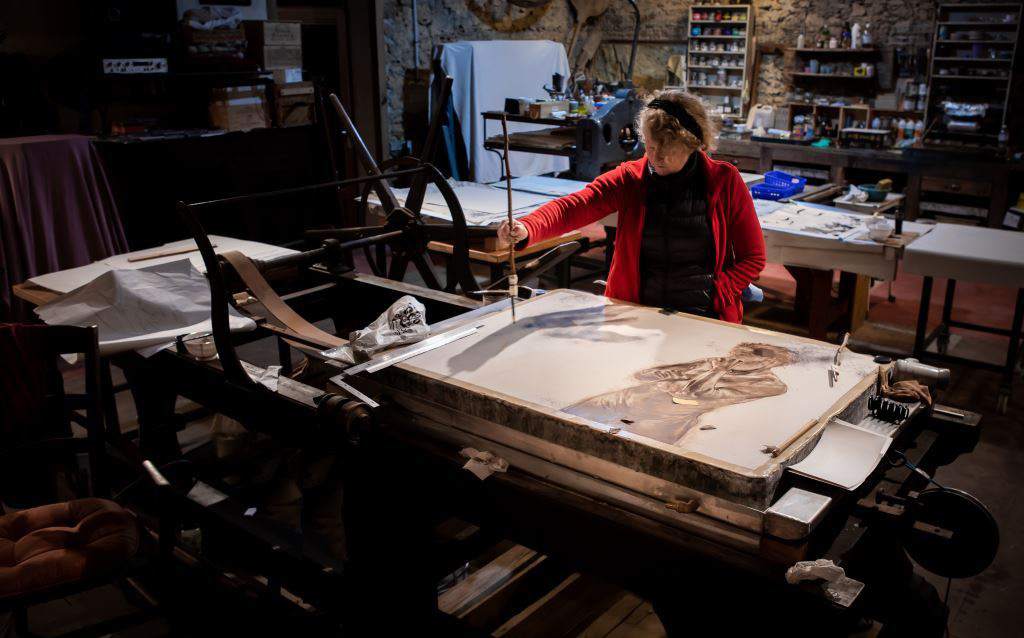MATTERS OF THE ART
Socially critical, not necessarily dark, and free of subtlety – Diane Victor on art and catharsis

Artist Diane Victor uses visual communication to make people think, consider and reimagine.
Diane Victor is an established South African artist and lecturer, currently exhibiting solo at the University of the Free State. She has more than 33 years of solo exhibiting experience, locally and internationally.
This exhibition was preceded by the resounding success of her captivating exhibitions earlier this year at Spier Wine Farm in the Western Cape and at Strauss & Co in Johannesburg.
Bongo Mei: What inspired the piece The Eight Marys?
Diane Victor: In 2004 I was invited by Hollard and Stevenson Gallery to create works for the exhibition Personal Affects: Power and Poetics in Contemporary South African Art. It [The Eight Marys] was exhibited at the Cathedral of St John the Divine in 2004. This exhibition showcased a number of contemporary South African artists.
Two venues were selected and the artists were invited to view these spaces and create artworks for them. One was the Cathedral of St John the Divine on Amsterdam Avenue, Manhattan, and the other was the Museum for African Art (now known as The Africa Center) in Queens, New York.
After viewing the spaces, I wanted to make a work that dealt with the secular, real-world living for the cathedral (and The Eight Marys were made for the cathedral), while I created Minder, Mater, Martyr for the museum.
The drawings for The Eight Marys were done to depict an alternative imagined life for the Virgin Mary. A young unmarried woman who falls pregnant and in the context of what could have happened – what if she had an abortion and was angry? She was given a contemporary, alternative life. When these works were displayed at Spier in February 2023, it was the first time I’d seen them since making them in 2004. They were made as site-specific artworks for the cathedral – they fitted into the windows, four storeys up.
At the end, as seen in the artwork, she is a frustrated old woman in a wheelchair, whose son was taken away from her.
The intention was for the viewer to think of that story from a real-life point of view as opposed to the idealised woman who cooks and cleans for her family.
Minder, Mater, Martyr are the depictions of St Sebastian, Christ and John the Baptist, but subverted and repositioned as female roles. They were displayed in the secular [section] at the Museum for African Art.
BM: When it’s said that your work is dark, does that relate to the appearance or content of the artwork?
DV: I would say that my work is socially critical, not necessarily dark. And free of subtlety. Having works that are shocking and free of subtlety, and have a sense of cynicism to them, is a conscious act and part of the context of my work – to make people think and consider and reimagine.

Diane Victor working on stone at Atelier le Grand Village. (Photo: Supplied)
But creating works that are socially critical is a cynical approach to the deeper aspects of humanity and social norms. It also carries my gallant approach to adding humour in dealing with these heavy, critical subjects.
BM: Is there a philosophical approach to your creative process?
DV: I am quite emotive and responsive, and the work I make is generally “in response to” some situation and it is often that I respond intuitively in an attempt to mediate the anger in myself.
Read more in Daily Maverick: The art of dreams and dead wood – South Africa’s ‘living treasure’ Noria Mabasa still a tireless inspiration
I draw images out of myself – things that I am frustrated by and angered by that I do not have the voice to speak out about. My drawing is my way of voicing my frustrations, angers and responses, and negotiating those feelings of self. It is a catharsis for me. For me, if someone is indifferent to my work, I have failed to be a visual communicator.
BM: Better the Devil You Know seems like a mythological interpretation. What motivated such visual expression?
DV: Better the Devil You Know is a drawing that I made just before my kidney transplant. At that time I had spent a number of years trying to find a donor and this was a stressful time for me.
In an attempt to combat this stress, I dealt a lot with fear and the linking of fear to one’s reptilian brain. For me the fear was the crocodile that I had to escape – if I let my guard down, the clock would ultimately continue ticking down and the crocodile was following me everywhere.
BM: Do you consider yourself a classical or contemporary artist?
DV: A bit contemporary, but first and foremost I consider myself as a person who draws pictures. My background and training is in realism and I take it figuratively.
My aim is not to alienate or preach to the converted, but to make my voice accessible and engaging. I use classical skills and methods in my works, but I use them in a way that is often cynical.
BM: Is The Goat Who Led the Flock a visual metaphor? What is the metaphor?
DV: The Goat Who Led the Flock is the middle panel of a triptych artwork. Certainly it is a metaphor, but it is part of a larger work that deals with religious iconography.
The first panel, The Boy Who Cried Wolf, the second panel, The Goat Who Led the Flock, and the third, The Girl Who Caused all the Trouble, are religious iconographies.
In The Goat Who Led the Flock, the goat and the child figure are based on John the Baptist. There is an artistry reference to a fairly well-known colonial painting of John the Baptist (the man who points the way). This panel in the triptych acts as the binding between the two iconographies (the Christ child and the Mary child).
While all three panels are seen as children’s games, there is an inherent underlying violence that the religious story carries, and almost bestiality of what human life is. By subverting these religious icons into children, I change that narrative of the Divine. DM
This story first appeared in our weekly Daily Maverick 168 newspaper, which is available countrywide for R29.





 Become an Insider
Become an Insider
Comments - Please login in order to comment.